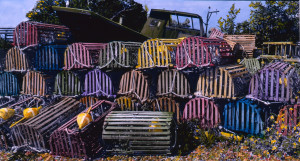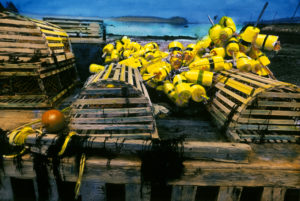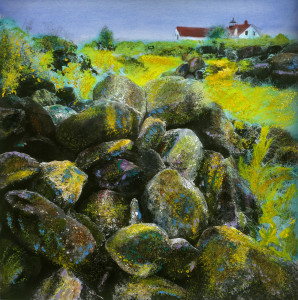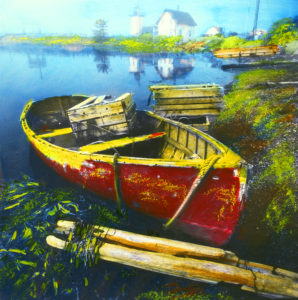In New England photographs are found underfoot and close at hand. Unlike shooting in the West where you tilt your lens upward toward magnificent expansive panoramas, when I take out my cameras in New England, it’s to take aim at details of the landscape.
I especially love the tidal zones where water laps the shore and the tide scours the beaches and rocks. There lurks interesting evidence of man’s presence among the ocean debris—coils of rope, broken skiffs, and lobster buoys. Because New England is monochromatic for much of the year, I often shoot in B&W, and sometimes paint my prints with vigorous hues of craypas and transparent oils.
I agree with Ansel Adams that the negative is the score, and the print is the performance. Perhaps, because my involvement with the final print has always been such a hands-on affair, I like to play with various ways to extend my relationship to the surface of the print, using toning techniques and split development times. I sometimes paint liquid emulsion onto watercolor papers; and I make polaroid image transfers, which I hand-color with pastels and oil Recently I’ve returned my attention to shooting with B&W infrared film and creating B&W prints which I paint with craypas and transparent oils. This old technique was made famous at the turn of the century by photographer Wallace Nutting, who organized cottage workshops of painters who applied color over his B&W prints. Nutting prints became wildly collectible, moving from flea market stalls and garage sales, to gallery boutiques and antique shops.
Historically, hand-painted photographs tended to be pastel tints and watery washes of color over dreamy landscapes delicately interpreted—ladies swathed in airy gauze or mordant flowers tumbling silently from a porcelain vase. A hint of gesture, a wisp of color.
But, my preference is to use paint boldly from the tube, rather than diluting it with a thinning medium. So what you see in my prints is a deeper intensity of color. Instead of a lovely, delicate scene, I prefer to turn my eye on more gritty subject matter, wandering the backlots of marinas, and searching through shoreline detritus.
I print these scenes on fine art photographic papers that have old-fashioned “tooth” that facilitates the hand-painting process, such as Kodak Elite, Oriental Seagull, Luminos Pastel Silver, and Classic Tapestry. Each B&W print is painted with a quirky color intuition and gritty textural manipulation using craypas or Marshall’s transparent oils, applied with cotton swabs, sable brushes, and determined hand-rubbing techniques, and using painterly finishes like stippling, smudging, and layering of colors. This encourages me to straddle the line between paint and emulsion, playing with a print’s tactile surface and asking the question, “Is it a painting or a photograph?”
Taking things one step further, I create limited edition Digital Prints by rephotographing the hand-painted photograph with my digital camera so I can print onto fine art watercolor-type of papers such as Somerset Satin or Hahnemeule Classic.
Two early editions are Rocks at Fort Pownal, and the Red Skiff at Grindle Point, which are part of the At Water’s Edge series. A subsequent collection titled Junkyard Dogs captures stored treasures located in marinas, Cliff Houle’s Up-Island junkyard, and in barns and storage sheds across the island. And a third collection takes you behind the scenes at Mystic Seaport Workshops.
Editor’s Note: Many of these hand-painted photographs can be seen on Jack’s website www.sevenknotsgallery.com in two collections called At Water’s Edge and Junkyard Dogs. Small prints, posters and notecards are for sale in the Art of the Isles Gallery at the Islesboro Community Center, and large hand-painted prints can be ordered on the Purchase page of the website, www.sevenknotsgallery.com.






